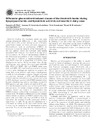Identificador persistente para citar o vincular este elemento:
https://accedacris.ulpgc.es/jspui/handle/10553/77936
| Título: | Differential glucocorticoid-induced closure of the blood-milk barrier during lipopolysaccharide- and lipoteichoic acid-induced mastitis in dairy cows | Autores/as: | Wall, Samantha K. Hernández Castellano, Lorenzo Enrique Ahmadpour, Amir Bruckmaier, Rupert M. Wellnitz, Olga |
Clasificación UNESCO: | 3104 Producción Animal | Palabras clave: | Mastitisblood-milk barrier Glucocorticoid Endotoxin |
Fecha de publicación: | 2016 | Publicación seriada: | Journal of Dairy Science | Resumen: | Bacteria invading the mammary gland can cause pathogen-dependent differences in the permeability of the blood-milk barrier leading to the differential paracellular transfer of blood and milk components. Glucocorticoids such as prednisolone (PRED) are known to increase the integrity of the blood-milk barrier and quickly restore the decreased milk quality associated with mastitis. The objective of this study was to examine the effect of intramammary PRED on the differential permeability of the blood-milk barrier during mastitis induced by lipopolysaccharide (LPS) from Escherichia coli or lipoteichoic acid (LTA) from Staphylococcus aureus. Thirty-one dairy cows, divided into 6 groups, were injected via a teat canal with LPS, LTA, LPS and PRED, LTA and PRED, saline (control), or PRED. Milk and blood samples were collected 0 to 8 h after challenge and analyzed for somatic cell count, IgG, serum albumin, and lactate dehydrogenase in milk, or α-lactalbumin in plasma. Somatic cell count was similarly elevated in LPS- and LTA-challenged quarters and was reduced to control quarter levels only in LTA-challenged quarters with PRED administration. Lactate dehydrogenase activity was highly elevated in LPS quarters and only slightly elevated in LTA quarters, but decreased to control quarter levels with PRED administration. For serum albumin and IgG, only LPS quarters showed an elevation in concentration and PRED treatment reduced the concentration to control quarter level. We found no differences in α-lactalbumin concentrations in plasma in PRED-treated cows compared with cows that only received LPS or LTA. In conclusion, the pathogen-specific appearance of blood constituents in milk during mastitis demonstrates a differential activation of the blood-milk barrier that, in turn, can be manipulated by intramammary glucocorticoids. The results show that the administration of PRED during mastitis increases the blood-milk barrier integrity but has implications in reducing the transfer of IgG that specifically occurs during E. coli mastitis. In addition, it can also reduce the number of migrating immune cells dependent on the mastitis-inducing pathogen. Potential effects of PRED on the cure of naturally occurring mastitis have to be taken into consideration. | URI: | https://accedacris.ulpgc.es/handle/10553/77936 | ISSN: | 0022-0302 | DOI: | 10.3168/jds.2016-11093 | Fuente: | Journal of Dairy Science [ISSN 0022-0302], v. 99(9), p. 7544-7553 |
| Colección: | Artículos |
Citas de WEB OF SCIENCETM
Citations
50
actualizado el 08-jun-2025
Visitas
55
actualizado el 03-sep-2022
Descargas
78
actualizado el 03-sep-2022
Google ScholarTM
Verifica
Altmetric
Comparte
Exporta metadatos
Los elementos en ULPGC accedaCRIS están protegidos por derechos de autor con todos los derechos reservados, a menos que se indique lo contrario.
